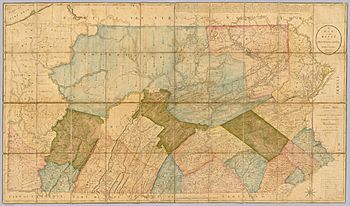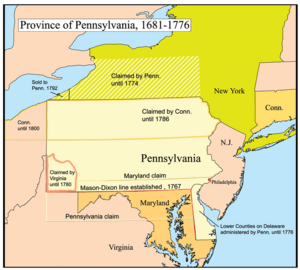State of Westmoreland facts for kids
Quick facts for kids
State of Westmoreland
|
|
|---|---|

A map of Pennsylvania in 1792 showing Luzerne County in the northeast. At the time, the future counties of Bradford, Lackawanna, Susquehanna, and Wyoming were still part of Luzerne County.
|
|
| Status | Not admitted |
| Capital | Wilkes-Barre (proposed) |
| Common languages | English |
| Today part of | Pennsylvania |

The State of Westmoreland was a plan for a new state that almost happened. It would have broken away from Pennsylvania in 1784. This idea came about after the Congress of the Confederation decided that the land belonged to Pennsylvania, not Connecticut.
Contents
Why Was Westmoreland Proposed?
The Land Dispute: Who Owned the Land?
For many years, both Pennsylvania and Connecticut believed they owned the same piece of land. This land was located between 41° N and 42° N latitude. This disagreement led to a series of fights called the Yankee-Pennamite Wars. These conflicts happened off and on from 1769 to 1799.
Both states had given out land to settlers in this area. They also set up their own governments there. Connecticut called its part "Westmoreland County." It even had a representative in its government from the Wyoming Valley, where many Connecticut settlers lived. Pennsylvania, on the other hand, included these areas in its Northumberland County.
The Decision: Who Was Right?
After the American Revolutionary War, the new national government, called the Congress of the Confederation, had to decide. They needed to figure out which state legally owned the land.
On December 30, 1782, the government made its decision. This was known as the Decree of Trenton. They officially ruled that the land belonged to Pennsylvania.
After this decision, Pennsylvania said that the Connecticut settlers, often called "Yankees," were not citizens of Pennsylvania. This meant they couldn't vote. They were also told to give up their land claims.
The Conflict: Settlers Fight Back
In May 1784, armed men from Pennsylvania forced the Connecticut settlers to leave the valley. But the settlers didn't give up. In November, they returned with more people and strength. They captured and destroyed Fort Dickinson.
After this victory, a leader named Captain John Franklin had an idea. He suggested that a brand new state should be created. This state would be separate from both Connecticut and Pennsylvania. He proposed to call it Westmoreland.
How the Conflict Ended
Finding a Solution: The Compromise
To stop more fighting, Pennsylvania changed its mind. It agreed to a compromise. The state decided that the land claims made by Connecticut settlers before the Decree of Trenton would be honored. This meant those settlers could keep their land. If a Pennsylvania settler also claimed the same land, they would get new land grants as compensation.
Most of the Connecticut Yankees accepted this plan. Part of the compromise involved creating a new county from a large part of Northumberland County.
Creating Luzerne County
On September 23, 1786, the Pennsylvania General Assembly officially created Luzerne County. It was named after the French minister, the Chevalier de la Luzerne. This new county was very large. Later, other counties like Lackawanna, Wyoming, Susquehanna, and part of Bradford counties were formed from its territory.
This compromise stopped the idea of the State of Westmoreland from becoming a reality. However, some disagreements about the land continued among residents even into the 1800s.
It's important to know that the proposed State of Westmoreland is not related to the current Westmoreland County. The modern Westmoreland County is in southwestern Pennsylvania. It was created much earlier, on February 26, 1773, by Governor of Pennsylvania Richard Penn.
Images for kids


